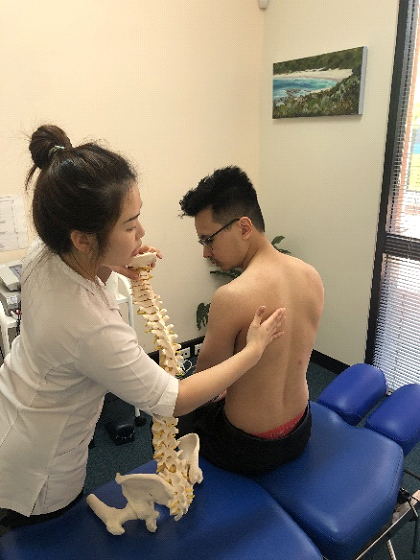
Upper Back Pain
Scheuermann’s disease, also known as Scheuermann’s kyphosis, juvenile kyphosis or juvenile Discogenic disease, is a deformity of the spine that develops during growth. It can lead to a rounded upper back (thoracic), commonly known as hump back. Scheuermann’s disease is one of the most common sources of back pain in in adolescents aged 12 to 17 years. In most cases, surgery is not required to treat Scheuermann’s disease.
Some effective treatment options include braces, mobilisations and flexibility exercise.
What Causes Scheuermann’s Disease?
The exact trigger for the abnormal growth of the spine is still unknown, but the rounded upped back is caused due to the limited growth of spine at the front, while the back of the spine continues to grow normally, forming a wedge-shaped vertebra, with the front part of the spine shorter than the back.
 Some possible causes of Scheuermann’s disease include:
Some possible causes of Scheuermann’s disease include:
- Hereditary, passed down from family members
- Pre-existing weakness with the cartilage and bone
- Excessive force on the bone
- Osteoporosis at young age
- Heavy lifting
- Posture problems
Symptoms of Scheuermann’s Disease
In most cases, patients suffering from Scheuermann’s disease will experience symptoms such as pain in upper back that is worsen with activity and improved with rest, rounded back that is rigid and does not resolve with bending backward or lying on the back, muscle stiffness and muscle fatigue of the back. However, in some cases, no significant symptoms can be seen.
Treatment options for Scheuermann’s Disease- upper back pain
The treatment for Scheuermann’s disease depends on the individual’s age, severity of the curve and any associated neurological problems.
Monitoring
For young individuals with slight rounding of the back who is still growing, no sign of curvature worsening and has mild to no pain may not require any treatment. Periodic X-rays should be used to monitor their curvature, if the curvature worsen, more active treatment would be recommended.
Braces
For young individuals with more than a year of growth left and more advance curvature, a back brace would be recommended. Back brace can help to stop or reverse the extra curvature by keeping the front of the vertebrae more upright and reduce some pain at the same time. To achieve the best result, braces should be worn most of the time throughout the day and depends on the severity and progression of the curvature, the individuals may be prescribed a brace for one to two years.
Exercises
Exercise and physical therapy is often recommended in conjunction with bracing. Exercise will not correct the curvature but it can help in improving flexibility of the back and reducing back pain or muscle fatigue. Exercises such as swimming and cycling are also recommended as they are both low-impact sports that can keep patients active but do not pose too much stress on their back. It would be best to avoid participating in high impact sports that involve jumping and heaving lifting as those are very likely to apply more stress on the back and might worsen the condition.
Physical Therapy
Physical therapy can be very beneficial for patients suffering from Scheuermann’s disease as physical therapists often provide useful advice and suggestions to increase patient’s awareness of the condition, suggesting on ways to live more comfortably with their condition and modify their daily activities to reduce the chance of developing chronic low back pain. Physical therapist such as chiropractor can also provide some treatments such as manipulations/mobilisations, soft tissue work, dry needling, exercises' and low-level laser therapy to reduce muscle tension and pain intensity.
At Lakeside Chiropractic, our trained chiropractors treat Scheuermann’s disease by applying dry needling (if you're okay with needles), spinal mobilisations or adjustments, soft tissue work, electrotherapy, providing exercise programmes and recommending the correct braces for you. We will try our very best to manage your Scheuermann’s disease as efficiently as possible. We are situated in the middle of Joondalup, Lakeside Chiropractic has many visitors from neighbouring suburbs including Jindalee, Ellenbrook, Ocean Keys, Burns Beach, Clarkson, Padbury and Beldon. We have HICAPS facilities on site to assist in the expense of your treatment and are BUPA and Medibank preferred providers, however take many others including, HIF, HBF, NIB, etc. To book an appointment you can contact us on 93000095 and speak with our receptionist or book via our ‘book now’ tab on our website www.lakesidechiro.com.au. We look forward to hearing from you soon and treating your condition.



